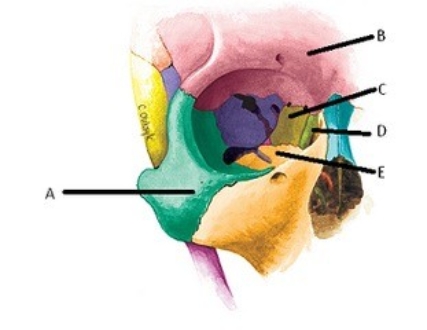A) intervertebral disk
B) vertebral foramen
C) lamina
D) intervertebral foramen
E) spinous process
G) B) and C)
Correct Answer

verified
Correct Answer
verified
Multiple Choice
Alexander has been diagnosed with a pituitary tumor, which means the tumor is in the ________.
A) crista galli
B) cribriform plate
C) sella turcica
D) pterygoid canal
E) foramen magnum
G) C) and D)
Correct Answer

verified
Correct Answer
verified
Multiple Choice
Which of the following facial bones is correctly matched with its function?
A) Maxilla - possesses sockets for teeth
B) Vomer - forms the hard palate
C) Inferior nasal conchae - contain nasolacrimal canals
D) Zygomatic - provides attachment point for temporalis muscle
E) Yemporal - is part of the orbit
G) A) and C)
Correct Answer

verified
Correct Answer
verified
Multiple Choice
A tumor discovered in the posterior orbit would most likely impact ________.
A) speech
B) vision
C) olfaction
D) memory
F) A) and C)
Correct Answer

verified
Correct Answer
verified
Multiple Choice
Which anatomical term is correctly matched with its description?
A) Condyle - a small, rounded bump
B) Spine - a low ridge
C) Tuberosity - a flat, tongue-shaped process
D) Meatus - a tunnel
E) Fossa - a ridge extending along the long axis of the bone
G) D) and E)
Correct Answer

verified
Correct Answer
verified
Multiple Choice
The largest and most superior region of the hipbone is the ________.
A) ischium
B) femur
C) ilium
D) pubic
E) coccyx
G) A) and E)
Correct Answer

verified
Correct Answer
verified
Multiple Choice
 -The figure illustrates bones of the right lower limb. What does "D" represent?
-The figure illustrates bones of the right lower limb. What does "D" represent?
A) Femur
B) Fibula
C) Tarsals
D) Tibia
E) Patella
G) D) and E)
Correct Answer

verified
Correct Answer
verified
Multiple Choice
 -The figure shows the bones of the right orbit. What bone does "D" represent?
-The figure shows the bones of the right orbit. What bone does "D" represent?
A) Frontal
B) Maxilla
C) Zygomatic
D) Lacrimal
E) Ethmoid
G) A) and D)
Correct Answer

verified
Correct Answer
verified
Multiple Choice
The knuckles of the hand are formed by the distal ends of the ________.
A) carpals
B) metacarpals
C) phalanges
D) tarsals
E) metatarsals
G) A) and E)
Correct Answer

verified
Correct Answer
verified
Multiple Choice
Which of the following statements concerning the vertebral column is true?
A) The cervical curve develops before birth.
B) The adult vertebral column has three curvatures.
C) Scoliosis is the term applied to normal curvature of the spine.
D) An exaggerated thoracic curvature of the vertebral column is called kyphosis.
E) Lordosis is an exaggeration of the cervical curvature.
G) None of the above
Correct Answer

verified
Correct Answer
verified
Multiple Choice
A coroner determines the cause of death to be strangulation because this delicate bone is fractured. Which bone is this?
A) Clavicle
B) C2
C) Sphenoid
D) Vomer
E) Hyoid
G) None of the above
Correct Answer

verified
Correct Answer
verified
Multiple Choice
Which of the following statements about the femur is TRUE?
A) The head of the femur articulates with the tibia.
B) The medial condyle articulates with the acetabulum.
C) Both the greater and lesser trochanters are attachment sites for muscles.
D) The distal end of the tibia articulates with the femur.
E) The proximal end of the femur articulates with the tibia.
G) C) and E)
Correct Answer

verified
Correct Answer
verified
Multiple Choice
The junction of two pubic bones is the
A) anterior superior iliac spine.
B) sacroiliac joint.
C) symphysis pubis.
D) iliac fossa.
E) ischial tuberosity.
G) A) and E)
Correct Answer

verified
Correct Answer
verified
Multiple Choice
Which of the following bones is part of the cranium?
A) Vomer
B) Nasal bone
C) Palatine bone
D) Occipital bone
E) Mandible
G) A) and E)
Correct Answer

verified
Correct Answer
verified
Multiple Choice
Failure of the palatine processes of the maxilla to fuse properly during development results in a ________.
A) cleft lip
B) cleft chin
C) cleft palate
D) deviated septum
E) clogged sinus
G) All of the above
Correct Answer

verified
Correct Answer
verified
Multiple Choice
Three-year old Trevor is admitted to the hospital with stenosis (narrowing) of the foramen magnum. This condition directly affects which of these structures?
A) Optic nerve
B) Carotid arteries
C) Internal jugular veins
D) Facial and vestibulocochlear nerves
E) Spinal cord
G) All of the above
Correct Answer

verified
Correct Answer
verified
Multiple Choice
A herniated disc occurs when
A) the body of a vertebra is fractured.
B) the covering of the spinal cord is torn.
C) there is a fracture of the vertebral arch.
D) there is protrusion of the nucleus pulposus.
E) spinal nerves are cut.
G) A) and E)
Correct Answer

verified
Correct Answer
verified
Multiple Choice
A patient was diagnosed with sinus polyps in the sinus associated with a flat bone that forms from fetal structures that fuse after birth. Which sinus is affected?
A) Frontal sinus
B) Spenoidal sinus
C) Ethmoidal sinus
D) Maxillary sinus
F) None of the above
Correct Answer

verified
Correct Answer
verified
Multiple Choice
Which of the following bones form the nasal septum?
A) Inferior nasal conchae and lacrimal bones
B) Vomer and ethmoid
C) Maxilla and vomer
D) Ethmoid and sphenoid
E) Nasal and vomer
G) B) and E)
Correct Answer

verified
Correct Answer
verified
Multiple Choice
Kevin was playing softball with some friends and was hit in the face by a ball fracturing one of the bones. Select the bone matched with its proper description that was most likely fractured?
A) Zygomatic bone - irregular
B) Temporal bone - short
C) Occipital bone - flat
D) Nasal bone - flat
F) None of the above
Correct Answer

verified
Correct Answer
verified
Showing 81 - 100 of 179
Related Exams